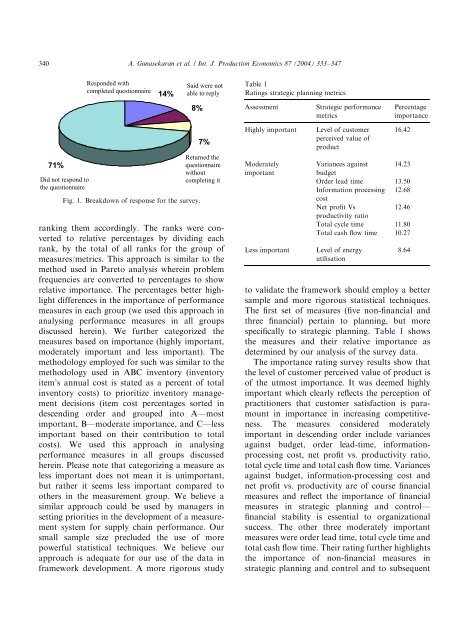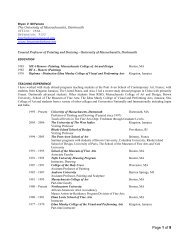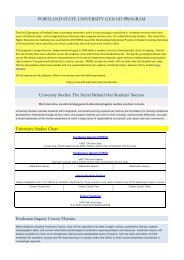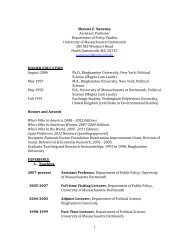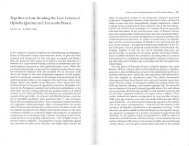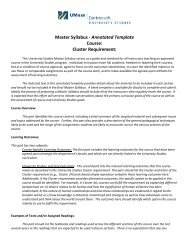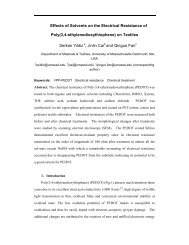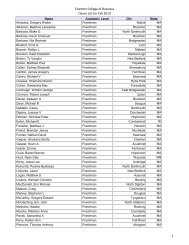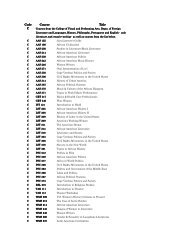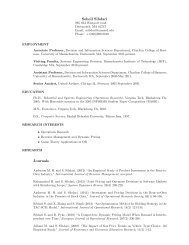ARTICLE IN PRESS340A. Gunasekaran et al. / Int. J. Production Economics 87 (2004) 333–347Responded withcompleted questionnaire14%Said were notable to replyTable 1Ratings strategic planning metrics8%AssessmentStrategic per<strong>for</strong>mancemetricsPercentageimportance71%Did not respond tothe questionnaireFig. 1. Breakdown of response <strong>for</strong> the survey.7%Returned thequestionnairewithoutcompleting itranking them accordingly. The ranks were convertedto relative percentages by dividing eachrank, by the totalof a lranks <strong>for</strong> the group ofmeasures/metrics. This approach is similar to themethod used in Pareto analysis wherein problemfrequencies are converted to percentages to showrelative importance. The percentages better highlightdifferences in the importance of per<strong>for</strong>mancemeasures in each group (we used this approach inanalysing per<strong>for</strong>mance measures in all groupsdiscussed herein). We further categorized themeasures based on importance (highly important,moderately important and less important). Themethodology employed <strong>for</strong> such was similar to themethodology used in ABC inventory (inventoryitem’s annualcost is stated as a percent of totalinventory costs) to prioritize inventory managementdecisions (item cost percentages sorted indescending order and grouped into A—mostimportant, B—moderate importance, and C—lessimportant based on their contribution to totalcosts). We used this approach in analysingper<strong>for</strong>mance measures in all groups discussedherein. Please note that categorizing a measure asless important does not mean it is unimportant,but rather it seems less important compared toothers in the <strong>measurement</strong> group. We believe asimilar approach could be used by managers insetting priorities in the development of a <strong>measurement</strong>system <strong>for</strong> <strong>supply</strong> <strong>chain</strong> per<strong>for</strong>mance. Oursmall sample size precluded the use of morepowerfulstatisticaltechniques. We believe ourapproach is adequate <strong>for</strong> our use of the data in<strong>framework</strong> development. A more rigorous studyHighly importantModeratelyimportantLess importantLevel of customerperceived value ofproduct16.42Variances against 14.23budgetOrder lead time 13.50In<strong>for</strong>mation processing 12.68costNet profit Vs12.46productivity ratioTotalcycle time 11.80Totalcash flow time 10.27Levelof energyutilisation8.64to validate the <strong>framework</strong> should employ a bettersample and more rigorous statistical techniques.The first set of measures (five non-financialandthree financial) pertain to planning, but morespecifically to strategic planning. Table 1 showsthe measures and their relative importance asdetermined by our analysis of the survey data.The importance rating survey results show thatthe level of customer perceived value of product isof the utmost importance. It was deemed highlyimportant which clearly reflects the perception ofpractitioners that customer satisfaction is paramountin importance in increasing competitiveness.The measures considered moderatelyimportant in descending order include variancesagainst budget, order lead-time, in<strong>for</strong>mationprocessingcost, net profit vs. productivity ratio,totalcycle time and totalcash flow time. Variancesagainst budget, in<strong>for</strong>mation-processing cost andnet profit vs. productivity are of course financialmeasures and reflect the importance of financialmeasures in strategic planning and control—financialstability is essentialto organizationalsuccess. The other three moderately importantmeasures were order lead time, total cycle time andtotalcash flow time. Their rating further highlightsthe importance of non-financialmeasures instrategic planning and control and to subsequent
ARTICLE IN PRESSA. Gunasekaran et al. / Int. J. Production Economics 87 (2004) 333–347 341Table 2Importance of order planning metricsAssessment Metrics PercentageimportanceHighly important Customer query time 19.11ModeratelyimportantProduct developmentcycle time17.37Less important Accuracy of <strong>for</strong>ecasting 16.59Planning process cycle 15.90timeOrder entry methods 15.51Human resourceproductivity15.51organizational success. The only strategic planningmeasure deemed less important was level of energyutilisation which may suggest that it is not ofstrategic significance. That, of course, could varyfrom firm to firm, depending on energy cost as apercent of totalmanufacturing cost and on energyprice levels relative to the prices of other manufacturinginputs.The percentage importance (relative importance)of the strategic per<strong>for</strong>mance metrics clearlysuggests that non-financialmeasures of per<strong>for</strong>manceare considered by practitioners to beimportant in assessing the competitiveness of anorganization. This is not to say that financialmeasures are no longer important, but rather thatnon-financialmeasures are important and necessaryin assessing a firm’s ability to compete.In Table 2, the order of priority <strong>for</strong> the orderplanning level metrics is presented. At the orderplanning level, customer query time was highlyimportant, which would seem to emphasize theimportance of customer service. Product developmentcycle time and <strong>for</strong>ecasting were moderatelyimportant. These two factors relate to meetingcustomer needs and doing so in a timely fashion.Although there is no statistical evidence containedherein to prove such a link, common sensesuggests a link between these and the perceivedcustomer value of the product, rated number oneamong the strategy per<strong>for</strong>mance measures. Theimportance ratings of product development cycletime and <strong>for</strong>ecasting measures suggests that theywarrant monitoring by management and improvementef<strong>for</strong>t. Cross-functionalteams, rapid prototyping,and concurrent engineering involvingsuppliers would seem appropriate in ef<strong>for</strong>ts toimprove product development cycle time. Manyalternative techniques are available <strong>for</strong> <strong>for</strong>ecasting.If <strong>for</strong>ecasting accuracy is a concern, firms mightexamine the techniques employed with an eyetoward improvement. Because the <strong>for</strong>ecasts of all<strong>supply</strong> <strong>chain</strong> links can influence <strong>supply</strong> <strong>chain</strong>per<strong>for</strong>mance, a concerted ef<strong>for</strong>t by all should bemade to assure accurate <strong>for</strong>ecasts. This is emphasizedby a survey participant (a machine toolmanufacturer) who said that <strong>supply</strong> <strong>chain</strong> partnersshould ‘‘Use better <strong>for</strong>ecasting techniques to removeuncertainties in <strong>supply</strong> <strong>chain</strong>.’’ Many understandthe consequences of weak <strong>for</strong>ecastingper<strong>for</strong>mance and recognize the need to measureand improve it.By benchmarking their <strong>for</strong>ecasting methodswith those of the best, a better understanding thetechniques might be gained and greater accuracyachieved. Also, by integrating production scheduleswith others in the <strong>supply</strong> <strong>chain</strong>, moreaccurate day to day demand <strong>for</strong>ecast might bepossible <strong>for</strong> all links in the <strong>supply</strong> <strong>chain</strong>. Planningprocess cycle time, order entry methods, andhuman resource productivity were the less importantorder planning measures. Planning processcycle time and order entry methods could beimproved through reengineering ef<strong>for</strong>ts that includemultiple links in the <strong>supply</strong> <strong>chain</strong>, becausethe actions of multiple participants interact toinfluence per<strong>for</strong>mance in these areas. Improvementsin customer query time, product developmentcycle time and planning process cycle timemight be brought about by greater humanresource productivity, so although it was ratedlast in importance, human resource productivityshould not be dismissed as unimportant. Improvementin order entry methods, customer query time,<strong>for</strong>ecasting accuracy and customer query timemight be brought about through the application ofin<strong>for</strong>mation technology to increase accuracy andexpedite the flow of in<strong>for</strong>mation throughout the<strong>supply</strong> <strong>chain</strong>. Process cycle time can be tackled byusing techniques like single minute exchange of dieand group technology, whereby similar facilities


